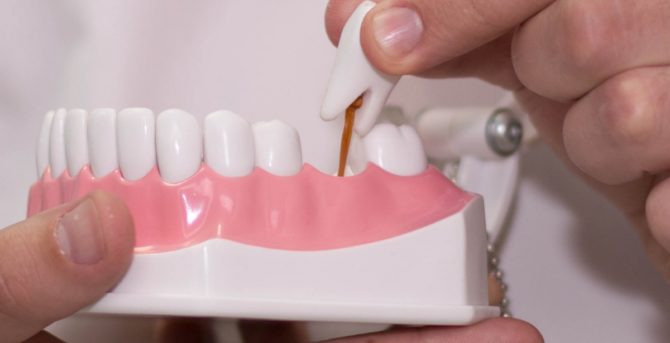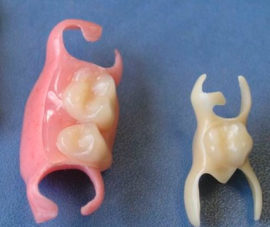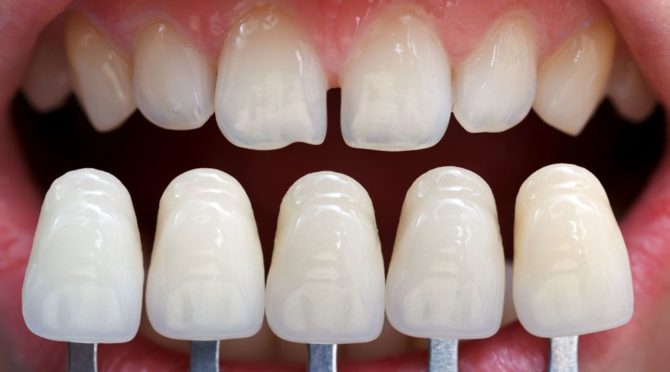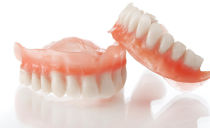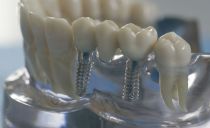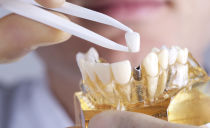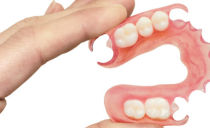Classification of prosthetics, types of dentures, how to choose the best
Even a partial absence of teeth makes the process of eating food uncomfortable or painful, so many seek to restore the integrity of the dentition. Modern dentistry has a huge variety of types of dental prosthetics, each of which is characterized by its own characteristics, advantages and disadvantages.
Content
Classification of dental prosthetics
Restoring the functionality of the dentition through dental prosthetics is a common practice. Classification of types of dentures is carried out according to the following criteria:
- the possibility of self-removal of the prosthesis;
- coverage area;
- installation technology.
Types of dental prostheses by the method of their removal
According to this classification option all types of dentures can be divided into two main types: removable and non-removable. Each of them has its own subjective advantages and disadvantages, the structural difference between them is the ability to independently remove artificial teeth - without the participation of medical staff and the use of special dental tools.
Removable dentures
All types of removable dentures can be removed from the oral cavity. Serving such a prosthesis is even easier than brushing your teeth. For their manufacture, polymers are most often used - nylon prostheses and acrylic prostheses are lightweight and ductile.
Among the shortcomings of removable prostheses, one can distinguish only that some inserted structures fall out of the mouth during use, others are characterized by rapid wear, the creation of an increased load on the gums or an unaesthetic appearance.
What are the removable dentures used by modern dentistry clinics:
- lamellar;
- clasp;
- a sandwich;
- butterflies.
All types of removable dentures do not require preliminary preparation of the patient's oral cavity before installation. The only prerequisite is to take an impression from the surface of the gums and abutment teeth to produce the most suitable product in shape and size.
Fixed prostheses
Fixed options for prosthetics are characterized by the lack of the ability to independently extract prostheses from the oral cavity. They are installed on a pre-prepared base, the remaining whole teeth are used as a supporting element. To fix the products, dental cement is most often used, which ensures reliable adhesion of the prosthesis to the support.
The following types of fixed dentures are available:
- crowns;
- bridges;
- tabs
- veneers, lumineers, microprostheses.
The cost of a high-quality non-removable structure along with installation is often several times higher than the price of a removable structure with the same coverage area. The advantages of this type of prosthetics include high structural durability of products and the best imitation of the dentition both in appearance and in functionality.
Types of prosthetics by coverage
The dimensions of the structures depend only on the number of dental units replaced by them, so the classification of prosthetics is as follows:
- complete jaw prosthesis;
- partial jaw prosthesis;
- single prosthesis;
- microprosthesis.
Complete removable dentures are used with full adentia. The support when using the removable structure is the gum and part of the palate when installed on the upper jaw or gum and part of the hyoid space - on the lower jaw. In fact, such designs are full-fledged false jaws.
A partial jaw prosthesis is used to restore the integrity of the dentition in the absence of one or more teeth. The nearest teeth serve as a support for removable structures, which allows you to better distribute the load when chewing food. Often insertion products of this type differ from complete dentures only in the presence of holes for the patient’s remaining teeth and attachments to the supporting posterior teeth. An example of a fixed prosthesis of this type is a bridge structure on implants.
A single prosthesis either replaces one lost tooth, or returns the functionality and aesthetic appeal to a damaged but preserved tooth. Such designs include not only prostheses, but also crowns, veneers, lumineers.
Microprostheses are installed on damaged teeth to restore their structural integrity and functionality. Filling is the most common dental service of this type.
Technological classification of types of dentures
The types of dental prostheses used in modern prosthetics differ significantly in their design features. A variety of technologies allows you to restore the integrity of the dentition to people who have contraindications to the installation of structures of a certain type. In the absence of contraindications, the selection of a suitable prosthesis may depend on both the convenience of its use and cost.
Laminar prosthesis
One of the simplest technologies for the manufacture and installation of a removable structure is laminar. The product is a rigid base applied to the gum, like a suction cup, relative to which imitators of teeth made of different materials are attached.
Such a prosthesis is inexpensive, has no contraindications. A suction cup prosthesis can be used with complete adentia - in the complete absence of incisors, fangs and molars.
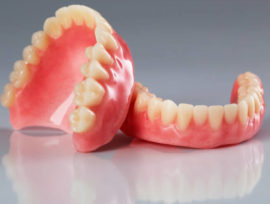 The product is made by cast and can be installed on the day of the first visit to the dentist. If there are healthy teeth, holes will be left in the prosthesis, chewing teeth in this case will serve as supporting teeth.
The product is made by cast and can be installed on the day of the first visit to the dentist. If there are healthy teeth, holes will be left in the prosthesis, chewing teeth in this case will serve as supporting teeth.
The disadvantage of this type of prosthesis is the low level of convenience. During operation, the structure does not hold too firmly, and its loss is prevented only with the help of special fixing pastes. The presence of emphasis on the palate or sublingual region causes impairment of diction, increased salivation and impaired taste buds. The design requires regular replacement due to wear.
Clasp prosthesis
The clasp type is better and more perfect than the plate type. Its base is a cast metal frame made of stainless alloys (mainly from nichrome). Parts that mimic the gums and teeth are similar to a plate prosthesis.
Clasp dentures can be classified by type of attachment. A prosthesis on clasps (hooks) is cheaper and can be used with full edentia, a prosthesis on locks requires the presence of back supporting teeth, to which it is attached in the oral cavity.
Clasp dental prostheses are better, more stable and more reliable than plate prostheses, do not interfere with the taste buds, but may not meet the aesthetic requirements of the patient. The prosthesis on the locks can be noticeable due to the metal fixing elements, the installation of the structure on the clasps is devoid of this drawback.
Sandwich
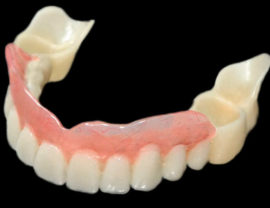 Dental construction "Sandwich" combines the strengths of clasp and plate-like products. It has no unmasking elements and does not overlap the sky or the hyoid area. As a support for its installation, molars or their roots are used.
Dental construction "Sandwich" combines the strengths of clasp and plate-like products. It has no unmasking elements and does not overlap the sky or the hyoid area. As a support for its installation, molars or their roots are used.
You cannot insert a “Sandwich” with full edentulousness - when even the roots are not left from the dentition. If the teeth are missing, but the roots remain, the possibility of its application remains. Professional dentists claim that the design of this type is better than clasp.
Prosthetic butterfly
A denture, known as a butterfly, is used to replace one or more lost teeth in a row. It is made from polymers: acrylic, nylon.
The mechanism of fixation of the butterfly prosthesis is polymer clasps on the sides of the structure. They are attached to the teeth on the sides of the prosthetic area of the dentition, so the installation of a “butterfly” to replace the posterior molars is impossible. If the gap between the abutment teeth is more than three teeth, the use of this technology is also excluded.
The weakness of this prosthesis is its low durability, justified by its low price. The design can cause discomfort and pain in the supporting teeth. If more than two weeks have passed since the installation, the presence of discomfort during the operation of the prosthesis is an occasion for another visit to the dentist.
Implants and bridges
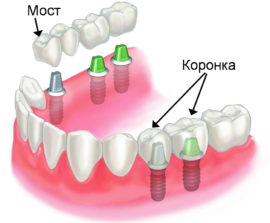 Implants are the general name for fixed dentures, which are supported by the bone tissue of the jaw. By implant, it is customary to mean only the part made of metal that serves as a connecting link between the future prosthesis of the tooth and the bone.
Implants are the general name for fixed dentures, which are supported by the bone tissue of the jaw. By implant, it is customary to mean only the part made of metal that serves as a connecting link between the future prosthesis of the tooth and the bone.
Such types of dental prostheses as crowns and bridges are placed on implants (see photo). The difference between them lies in the area of coverage and in the ratio of the number of installed implants to the number of simulated teeth.
One crown is placed on one implant; when choosing a bridge, implants become a support for more artificial teeth.
Bridges also have their own classification. They can be installed on two implants or on a larger number of them, depending on the length of the prosthetic area of the dentition. The dental bridge is made both in the form of an integral product, and in the form of a composite structure depending on the wishes of the patient. If the bridge is not installed on the implants, but on its own adjacent teeth, there is a need for their cutting (grinding).
All types of dentures and fixed bridges on implants require surgical intervention. The patient must undergo a complete medical examination aimed at identifying contraindications for the procedure. There are a lot of contraindications to implantation - from poor bone condition to low blood coagulation.
After implant placement, rehabilitation is required. After this, temporary crowns are placed so that the gum takes the desired shape in the places of attachment of future artificial teeth.
Despite the high cost of such prosthetics, a large list of contraindications, possible complications and prolonged rehabilitation, dental implants are in high demand, due to the positive characteristic of such products:
- Due to the metal base, the prosthesis does not cause allergies and rejection, has high strength.
- Patients quickly get used to the implanted design after installation.
- The applied dental cement provides a strong connection between the prosthesis and the implant, which is why this design has an unlimited service life.
- Another feature of this prosthetics technique is the perfect imitation of the dentition.
Veneers and Lumineers
Veneers and lumineers belong to cosmetic (aesthetic) prosthetics.They are lamellar designs that imitate the front of the tooth and are most often used in dentistry to hide defects in incisors or canines.
Dentures of this variety are used to hide defects in the structure of the tooth, which are not a disease, but spoil the aesthetics of the appearance of the dentition. The veneer is applied over the tooth and fixed with dental cement.. The approximate service life of plastic veneers is at least a year.
What to choose for the patient
Many dentists consider the installation of crowns on implants the best option for prosthetics. Such designs are as durable as possible, reliable and convenient. To study the pros and cons of other types of prosthetics in order to choose the best is advisable only in two cases: in the absence of funds for the installation of implants or in the presence of a large number of contraindications that do not allow making a choice in their favor.

